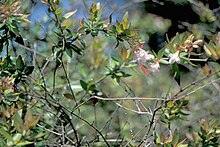Abelia
| Abelia | |
|---|---|

| |
| Glossy Abelia (Abelia x grandiflora) | |
| Scientific classification | |
| Kingdom: | |
| (unranked): | |
| (unranked): | |
| (unranked): | |
| Order: | |
| Family: | |
| Genus: | Abelia |
| Species | |
|
See text | |
Abelia is a genus of about 15-30 species and many hybrids in the honeysuckle family Caprifoliaceae, in the part of that family split off by some authors in the segregate family Linnaeaceae. The Angiosperm Phylogeny Group considers Linnaeaceae to encompass such genera as Linnaea, Abelia, Dipelta, Kolkwitzia, and Zabelia.
Abelias are shrubs from 1-6 m tall, native to eastern Asia (Japan west to the Himalaya) and southern North America (Mexico); the species from warm climates are evergreen, and colder climate species deciduous. The leaves are opposite or in whorls of three, ovate, glossy, dark green, 1.5-8 cm long, turning purplish-bronze to red in autumn in the deciduous species. The flowers appear in the upper leaf axils and stem ends, 1-8 together in a short cyme; they are pendulous, white to pink, bell-shaped with a five-lobed corolla, 1-5 cm long, and usually scented. Flowering continues over a long and continuous late spring to fall period.
- Selected species
|
|
- Hybrids
- Abelia x grandiflora Hort. ex. Bailey

Cultivation and uses
Abelias are popular garden shrubs. The most widely grown is the hybrid Abelia x grandiflora (Glossy Abelia; hybrid Abelia chinensis x Abelia uniflora). This is a rounded, spreading, multi-stemmed shrub with gracefully arching branches to 1-1.8 m tall, with ovate, glossy, dark green semi-evergreen leaves to 2-6 cm long, and clusters of white-tinged-pink, bell-shaped flowers to 2 cm long.
Abelia species are used as food plants by the larvae of some Lepidoptera species - see list of Lepidoptera that feed on Abelia.
References and external links
- Barnes, P. 2001. Looking at Abelias. New Plantsman 8(2): 78-92 (clarification of nomenclature, history, and cultivars with an excellent key and photographs).
- Flora of China: Abeila species list
- Germplasm Resources Information Network: Abeila
- Mexican Abelia
- Abelia page
- Two new species of Abelia
